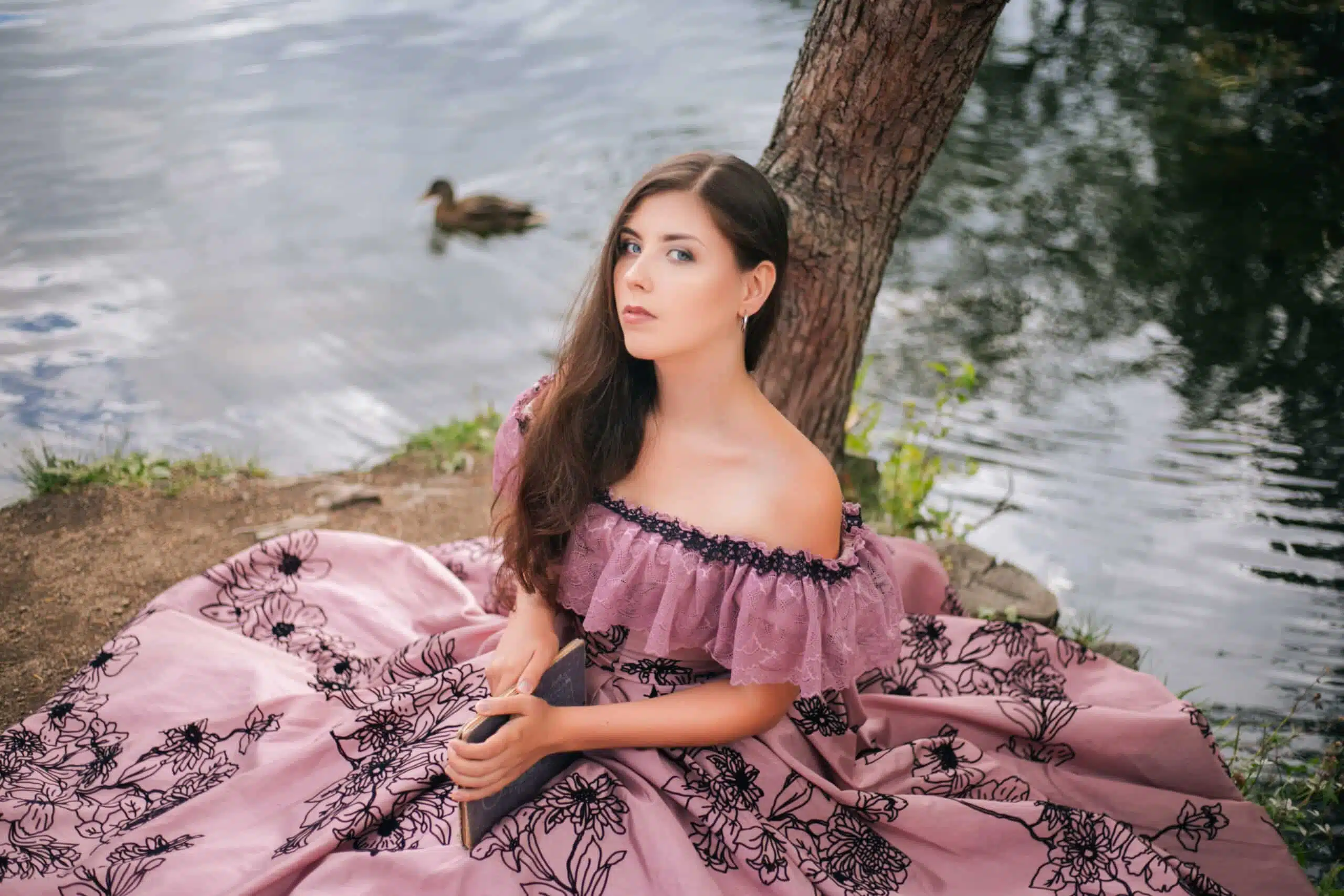Here’s what the Kyrielle poetry form is:
The kyrielle is a stanzaic French poetic form comprised wholly of quatrains.
The rhyme scheme can vary from poet to poet but is expected to be present, as is a refrain that will be featured throughout the entirety of the poem as the last line of every verse.
Each line of a kyrielle is octosyllabic (eight syllables).
So if you want to learn all about the Kyrielle poetry type, then you’ve come to the right place.
Let’s jump right into it!
- Dizain Poetry Form: Speak in Passionate Tones
- Rondeau Poetry Form: Croon to Love’s Anthem
- Ballade Poetry Form: Unlock the Sonata of Desire

Forms of Poetry: The Kyrielle

The kyrielle is a French form consisting of rhymed quatrains with octosyllabic lines.
While it doesn’t have many admirers in English it is nonetheless a prominent form of France, enough so that it even has some unusual variations, such as the kyrielle sonnet.
Unlike many other forms which designate an exact beginning and end, the kyrielle can go on for as many quatrains as the poet deems necessary.
This will rarely exceed a moderate length, however, since the poem heavily features a refrain and can become redundant quickly if it is allowed to overstay its welcome.
Basic Properties of a Kyrielle

| Rhyme Structure | Flexible but expected |
| Meter | Unmetered |
| Origin | France |
| Popularity | Largely restricted to France |
| Theme | Varies |
How Is the Kyrielle Structured?

The kyrielle is based entirely on quatrains.
Lines are octosyllabic and the poem includes a refrain that will be repeated at the end of every verse.
The bare minimum length is two stanzas (else the refrain wouldn’t work) but the poem can be as long as the poet would have it be.
The poem always features rhyme but there are many agreed upon rhyme schemes, with three of the most prominent being aabB, abaB, and abcB, where the capital ‘B’ represents the refrain in the last line of each verse.
The poet is generally free to experiment as long as their scheme is reasonable within the form.
Four-line verses with eight syllables per line is a refreshingly natural length for most poets to achieve.
It’s just enough space to comfortably set up the end sounds so that the rhymes can feel organic instead of forced, while not being long enough for any idea to get stale.
The refrain can undergo slight alterations from verse to verse in order to maintain a semblance of variety, as long as it is still recognizably intended to be a refrain.
So something like “He stood there with such deep regret” might become “But he stood by that deep regret” in a subsequent verse.
Longer kyrielles in particular can benefit from these small tweaks, but it’s advisable to choose at least one phrase in the line that will always remain static.
Example of a Kyrielle

Distractions
Deep beneath my blankets, I weep
for the sweet release of soft sleep
will not beckon me to rest here
for many thoughts are still not clear.
The plans I should handle all fall
around my neck with the harsh call
of chains clanging against my ear
because my thoughts are still not clear.
So it is that I lay here sobbing
as daylight soon will be robbing
me of my chance, and all these tears
do not help thoughts that are not clear.
The above example does use different rhymes for the ‘a’ sound in each verse, but note that the rhyme scheme is consistently aabB, internally.
This particular poem, despite being relatively short, features heavy changes to the refrain from line to line, only barely drawing within the lines as far as refrains go.
Nonetheless, the feeling of the repetition is retained even with the modifications.
This is one way to get more mileage out of the refrain instead of having it weigh down the poem, which it might otherwise do if poorly managed.
This kyrielle sticks with short words (one and two syllables) in order to easily hit the expected length of each line without going over.
When in doubt, remember that you can always shoot just under eight syllables, then find room for an adjective or adverb that adds to the line in some way.
The Kyrielle Sonnet

It wouldn’t truly be a poetic form without someone somewhere trying to turn it into a sonnet, and the kyrielle is no exception.
While it’s unclear why poets have such a strange fascination with turning everything they see into a 14-line version, it does work rather well with this form, since the rhyme scheme and line lengths are already somewhat reminiscent of traditional sonnets.
This form, roughly speaking, is a trio of kyrielle quatrains capped off with a couplet. Unlike the more basic kyrielle, the kyrielle sonnet utilizes two refrains, though the first is only used exactly twice in the poem.
The rhyme scheme is generally either AabB ccbB ddbB AB or AbaB cbcB dbdB AB. Put simply, the quatrains will either favor rhymed couplets or alternating rhyme, while the final couplet actually does not rhyme within itself but does feature BOTH refrains.
Tips for Writing a Kyrielle

The refrain will be with you throughout the poem, so make sure it’s a line you can work with on multiple levels.
It should be easy to rhyme with, impactful, and should represent a good chunk of the meaning behind the poem.
Rhymes, in particular, will pose a problem as the poem gets longer and longer.
Since the refrain will always be present, any kyrielle structure that includes the refrain in its rhyme scheme will generally struggle more and more with finding words that rhyme with it as time goes on.
For that reason, you may want to invest in words that have common suffixes or that end in simple sounds (like vowels), to facilitate easier rhymes.
While you can exclude the refrain from the rhyme scheme so that it only rhymes with itself across the poem, this presents a different problem in which the refrain can become monotonous with less and less payoff.
Alternatively, it may be wise to simply cut the kyrielle off before you reach that point.
A kyrielle of two to four verses will generally not run into the aforementioned problems and just functions as a cute little formal poem, which is all it really needs to do.
Do not overextend the length unless you have a fair reason.
While being limited to exactly eight syllables per line may sound taxing, this is less problematic in practice than it sounds in theory.
English lends itself quite well to even-numbered lines, and various combinations of one and two-syllable words naturally add up to eight without exerting any particular effort.
When using longer words, three syllables and up, take note of how much space you have left in the line first.
Can you comfortably include this word and still remain limited to just eight syllables?
If not, quickly seek a shorter alternative to the same word. (A thesaurus can help.)
Poet’s Note

If you’ve ever thought French forms are strikingly similar to English forms, it’s not your imagination.
France and England share a (mostly bitter) history with each other, so there has been a great deal of interaction between the two countries, both for better and for worse.
Comprehensive Collection of Poetry Forms: Craft Words Into Art

Dare to traverse the entire spectrum of poetic forms, from the commonplace to the extraordinary?
Venture from the quintessential Sonnet to the elusive Mistress Bradstreet stanza, right through to the daunting complexity of Cro Cumaisc Etir Casbairdni Ocus Lethrannaigecht.
For those with a zeal to encounter the full breadth of poetry’s forms, this invitation is yours.
Start exploring the vast universe of poetic ingenuity with our comprehensive array of poetry forms right now!
